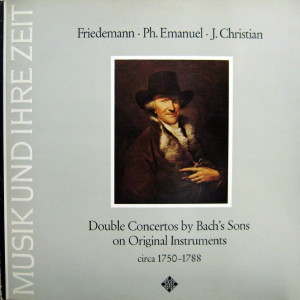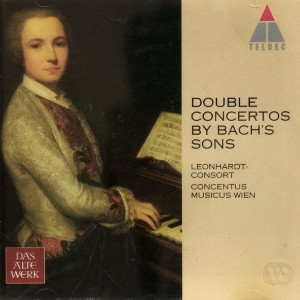 |
1 LP -
SAWT 9490-A - (p) 1967
|
 |
| 1 CD -
0630-12326-2 - (c) 1996 |
|
| Double Concertos by Bach's Sons
on Original Instruments - circa
1750-1788 |
|
|
|
|
|
|
|
| Carl Philipp Emanuel Bach
(1714-1788) |
|
|
|
| Double Concerto for
Harpsichord, 'Hammerklavier', 2 Flutes,
2 Horns, Strings and Bass in E flat
major |
|
|
|
| - Allegro
di molto |
|
6' 58" |
A1 |
| - Larghetto |
|
5' 09" |
A2 |
| - Presto |
|
4' 28" |
A3 |
|
|
|
|
| Johann Christian Bach
(1735-1782) |
|
|
|
| Double Concerto
(Sinfonia concertante) for Oboe,
Violoncello, 2nd Oboe, 2 Horns,
Strings and Continuo in F major |
|
|
|
| - Allegro |
|
7' 33" |
A4 |
- Tempo di Minuetto
|
|
3' 17" |
B1 |
|
|
|
|
| Wilhelm Friedemann Bach
(1710-1784) |
|
|
|
Double Concerto for 2
Harpsichords, 2 Trumpets, 2 Horns,
Timpani, Strings and Bass
|
|
|
|
- Un poco Allegro
|
|
11' 20"
|
B2 |
| - Cantabile |
|
2' 54" |
B3 |
| - Vivace |
|
7' 35" |
B4 |
|
|
|
|
LEONHARDT-CONSORT of Amsterdam
and CONCENTUS MUSICUS of Vienna
(with original instruments)
|
|
| Other
instrumentalists: |
Soloists: |
|
| -
Alice Harnoncourt, Violin |
-
Anneke Uittenbosch,
harpsichord |
|
| -
Marie Leonhardt, Violin |
-
Alan Curtis, harpsichord |
|
| -
Antoinette van den Homberg, Violin |
-
Jean Antonietti,
"hammerklavier" |
|
| -
Walter Pfeiffer, Violin |
-
Frans Brüggen, flute |
|
| -
Peter Schoberwalter, Violin |
-
Frans Vester, flute |
|
| -
Wim ten Have, Viola |
-
Carol Holden, natural horn |
|
| -
Lodewijk de Boer, Viola |
-
Thomas Holden, natural
horn |
|
| -
Nikolaus Harnoncourt, Violoncello |
-
Jürg Schaeftlein, baroque
oboe |
|
| -
Dijk Koster, Violoncello |
-
Karl Gruber, baroque oboe |
|
| -
Fred Nijenhuis, Violone |
-
Anner Bylsma, baroque
cello |
|
| -
Eduard Hruza, Violone |
-
Hermann Schober, trumpet |
|
| -
Karel van den Grient, Timpani |
-
Josef Spindler, trumpet |
|
|
|
| Gustav Leonhardt,
Conductor |
|
|
Luogo
e data di registrazione
|
| Hervormde
Kerk, Bennehroek
(Olanda) - giugno 1966 |
|
Registrazione
live / studio
|
| studio |
Producer
/ Engineer
|
-
|
Prima Edizione CD
|
Teldec
"Das Alte Werk" - 0630-12326-2 - (1 cd)
- 49' 31" - (c) 1996 - ADD
|
|
Prima
Edizione LP
|
Telefunken "Das
Alte Werk" - SAWT 9490-A - (1 lp) - 49'
31"
- (p) 1967
|
|
|
Notes
|
Carl Philipp Emanuel
Bach's Double Concerto for Harpsichord
and "Hammerklavier" is, if the date
1788 attributed to it is correct, the
latest of the three works on this
record. In any case it is the most
original. Bach's second son, a
lifelong experimenter, has intervened
here - in the year of his death - in a
process that must have occupied his
attention very much as the greatest
"expressive" master of the harpsichord
and clavichord: the displacement of
the "old" harpsichord by the "modern"
"Hammerklavier" (long decided by
1788), and has easily come to terms
with the situation. The solution he
offers is both conservative and
revolutionary at the same time. Once
again the harpsichord is used quite
naturally as a solo instrument
(Mozart's great piano concertos were
already written, but for the last, in
1788), but it is constrasted with its
victorius rival in such a manner that
the soundcharacter of both instruments
and their possibilities of colour are
effectively played off against one
another. The principle of "concertare"
has been transferred from a contest
between tutti and solo to a rivalry
between two principles sound
production and playing. It is thus
extended in a most ingenious fashion
into a reflection of the historical
competition between the two
instruments, the harpsichord having
more to say in the first movement, the
piano displaying its greater
melodiousness and the harpsichord its
greater agility in the second and the
piano not finally "setting the
fashion" until the Finale. That the
work falls between the epochs also
reveals iteself in the basic character
of its three movements in the
nervously resilient rhythms of the
"Hamburg Bach", the abrupt dynamic
contrasts and the amazing harmonic
changes, as well as in the already
quite classical, free and colourful
treatment of the wind, in the
adventurous virtuosity of the outer
movements and in the "cantilena" of
the Larghetto, noble yet continually
divided into finely-chiselled
ornamentation.
Johann Christian Bach's Sinfonia
Concertante, probably written during
the composer's later years in London
(ca. 1770-1781), is a genuine
"concertante" symphony after the
Parisian pattern, but completely
filled with the melodie grace and
gentle sensibility of this most
"galant" of composers. Like many
concertos, symphonies and chamber
music works of the pre-classical
period, this work has only two
movements - a large-scale Allegro in
free sonata form and an Italian Tempo
di Minuetto. Both derive their
substance from an ingratiatingly
song-like and graceful melodic style
that is essentially highly
conventional. But the manner in which
a concerto movement of the greatesr
elegance and finesse of form is built
out of these fashionable turns pf
phrase, how a delicately rustic mood à
la Watteau is distilled from the
Italian minuet character consitutes
the secret and the magic of the
"London Bach", who realized more truly
than any other composer of the 18th
century the ideal (by no means to be
despised) of a social are refined to
the utmost. A greater contrast in the
music of this century could hardly be
imagined than that existing between
this work and the Double Concerto of
the eldest and most un happy of Bach's
sons, Wilhelm Friedemann, which was
presumably written around 1750-60. It
is modelled on concertos by the father
in that it is written for two solo
harpsichords, and on the latter's C
major Concerto in that the middle
movement is a duet for the solo
instruments without orchestra.
Otherwise there is very little that
recalls his father's style - most
readily perhaps the heavy and
resplendent orchestral writing with
trumpets, horns and timpani, which is
still treated entriely in the manner
of a baroque tutti. Also baroque in
the character of the first movement
with its gloomy solemnity, its
"sighing" suspensions and its brief
chordal interjections by the tutti
into the big, virtuoso solo passages;
the harmony, on the other hands is
strongly reminiscent of the style of
his younger brother Carl Philipp
Emanuel in its surprise effects. In
spite of its key of C minor, yhe 3/8
Cantabile with its rapturous parallel
thirds and sixths, written in three
parts throughout, is more genial in
its effect than this mighty first
movement in the peculiar chiaroscuro
colouring which had already struck his
contemporaries in Friedemann's tyle.
The Finale combines the baroque sound
of the first movement with a thematic
material that is already quite early
classical, almost reminiscent of early
Haydn, and in typical finale
character. Even so, it is not yet able
to find the carefree finale spirit,
the "final dance" character of the
early classical period; the gloomy,
frequently fantastic-bizarre quality
that dominated Wilhelm Firdemann's
life just as much as his work is also
clearly in evidence here.
Ludwig Finscher
|
|
Nikolaus
Harnoncourt (1929-2016)
|

|

|
|